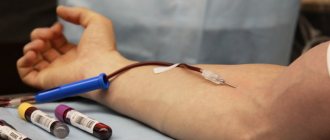Hygiene for boys: the principle of isolation
Before telling how to properly wash a boy (including a newborn baby), it makes sense to explain to mothers what the organ is that they will have to take such careful care of.
So, the penis of a newborn boy is designed in such a remarkable way that it is almost completely isolated from the outside world - the foreskin closes tightly over the head of the penis and does not allow either bacteria or any foreign objects to penetrate inside and harm the baby’s health.
Under the foreskin, a special lubricant is produced - the so-called smegma - which has a high antibacterial property and neutralizes those bacteria that have nevertheless penetrated under the skin.
In addition, the so-called “sheet” of the foreskin in infants is much more elastic than in adult men - since the elasticity of the skin in this area (that is, the ability of the skin to stretch) depends on the level of sex hormones in the blood. The higher the level of hormones, the more flexible and mobile the foreskin. Accordingly, the more “frankly” she can expose the head of the penis. And babies have practically no these hormones. Therefore, there is no way to see the head yet.
But over time, the baby grows - the foreskin gradually separates from the outer edge of the head and becomes more mobile. And at this moment, many mothers and other relatives begin to make one of the main mistakes in the intimate hygiene of a boy - when washing their little one and his “dignity”, they pull back the foreskin in order to wash with soap something that should not be washed at all yet...
Tips for parents
To ensure a successful bath with your child, you should follow these rules:
- To ensure that children feel normal during the procedure, buy products marked “no tears.” Try to avoid getting shampoo in your eyes, as not all manufacturers meet your expectations. If the purchased product does get into the eyes and the newborn cries, they need to be washed.
- When bathing your baby, do not use washcloths or sponges, as this increases the likelihood of damaging his skin. Wash your baby by hand.
- If the head quickly becomes dirty, then wear a hat on the baby more often.
- Gently blot the clean head with a towel and, if necessary, wrap it for 2–3 minutes. Rubbing your head is prohibited.
- Use a soft comb when your hair grows back.
Based on all of the above, it is recommended to wash a newborn’s hair from the first days of life. At the same time, parents must follow the rules, and if new questions arise, contact their pediatrician.
How to properly wash a boy
Modern generally accepted recommendations from pediatricians around the world say approximately the following: the procedure for a boy’s intimate hygiene (from the moment of birth until puberty) should be reduced to the ritual of daily external washing with baby soap. And you don’t need to do anything else!
Let us explain: external washing is washing the genitals only from the outside. And it in no way implies any attempts, even rare ones, to penetrate the boyish “holy of holies,” namely, under the tender foreskin, and “put things in order there.” Firstly, such an invasion on your part can be dangerous and traumatic for the child, and secondly, it is useless to “clean up” under the foreskin of a baby - tightly closed skin, which is partially not even separable from the head of the penis, reliably protects the penis the boy's organ from external pollution.
Finally, let's remember about smegma! If at every opportunity you pull back the delicate skin on the baby’s penis and wash the intimate area with soap or any other cosmetics, then you will not leave a trace of the valuable antibacterial lubricant that forms under the foreskin as a protective barrier... But it’s all the same , what to say to bacteria and infections “Welcome.”
Let us clarify once again: in order to properly wash a boy, you do not need to pull anything away from him, tuck or bend him, and then soap, rub and rinse. In general, there is no need to even touch his penis with your hands. The less you touch it, the healthier and more well-groomed it will be.
So, how to wash a boy:
- During the day, we wipe with wet baby wipes in case the baby “piles” in the diaper or in the potty.
- During nightly bathing, we wash the outside of the genital organ with warm water and soap, rinse well and don’t put our hands anywhere else!
Even if your baby needs to undergo any tests (for example, a urine test), this does not require any special preliminary cleansing procedure. Any sensible laboratory technician is able to understand that in the analysis of, for example, a one-year-old boy, an increased content of bacteria, mucous membrane cells, etc. is quite acceptable. For this purpose, the age and gender of the patient must be written down on the form.
Is the fontanel washed?
Often, many mothers are afraid of accidentally damaging the fontanelle, so they try not to touch this area. In fact, the fears are unfounded - the skin that covers the fontanel is dense enough to protect this vulnerable spot from damage. The only thing you need to do is wash the head very carefully. If you are afraid, you can only gently wash your hair without massaging the scalp in the fontanel area.
If you notice some “contamination” under the foreskin
So, over some time (on average from 1 month to the first 3 boyhood years), the foreskin gradually “peels off” from the head of the penis, acquiring a certain mobility. This process is accompanied by the death of cells in the inner layer of the foreskin and the outer layer of the head of the penis.
These cells are not “thrown out” immediately, but gradually accumulate under the foreskin, forming whitish clumps together with smegma. This is not dirt! It's not dangerous or scary. Gradually, these clusters of “outdated” cells move “towards the exit” and are separated when the boy pees.
In no case should you try to remove these whitish accumulations of cells with any special manipulations, supposedly for the purposes of cleansing and hygiene. For these purposes, on the contrary, they are located under the folds of the foreskin. Let us remember that smegma has antibacterial properties.
Which shampoo to choose
It is recommended to wash your child’s hair no more than once or twice a week using shampoo. The rest of the time, just clean water and herbs.
Which washing shampoo should you choose for water procedures? If the packaging simply says “children’s” without indicating the age, you can use this shampoo only when the child turns 3 years old.
High-quality shampoos are more expensive and are sold in pharmacies.
There are shampoos that combine the functions of a bathing and hair washing product. They are very easy to use. When choosing, you need to pay attention to the composition.
It is better to choose a product without synthetic fragrance, methylparaben, propylparaben. In high-quality shampoos, these components are replaced with essential oils, vitamins, lactic and plant enzymes.
My boy has phimosis. What to do?
Often, during one of the routine examinations, the pediatrician (or surgeon), having examined in detail the “causal site” of the baby boy, announces to the mother that her boy has phimosis. What is this and should I worry about it?
Phimosis is a situation in which exposure of the glans penis is difficult or impossible.
In the first month of life, the vast majority of newborn boys have phimosis. And doctors do not react in any way to his “presence”, because only in the second month the head of the penis just begins to open, but even then - only in 4 boys out of a hundred. Closer to the year, some doctors, as a rule, announce to the mother that the boy’s glans penis still does not open, but ask him not to worry too much. After three years, some pediatricians (usually surgeons) no longer just present this information, but often advise the mother to specifically retract the foreskin, thus allegedly “training” it.
It is worth keeping in mind that such advice in our time is regarded by modern progressive pediatricians not only as ineffective and meaningless, but also potentially traumatic.
Dr. O.E. Komarovsky: “In modern medical practice, in all pediatric associations and communities without exception, this manipulation has long been recognized as unnecessary, incorrect and traumatic. But often there are still doctors, probably respected and experienced, but at the same time conservative, who still advise some mothers to mechanically retract and spread the foreskin of their young sons, supposedly “for training purposes.” Alas, it is precisely such training that sometimes ends in serious injury.”
By severe injury, the respected Dr. Komarovsky means the condition of paraphimosis - a kind of pinching of the head of the penis, which often leads to necrosis and amputation. But more on this a little further.
So, phimosis in boys occurs in two types:
- Physiological phimosis (that is, normal, natural and passing on its own over time). The age limit for physiological phimosis is the end of puberty. This is quite a long period, on average up to 15-17 years. That is, during all these years, at any moment, physiological phimosis can disappear in a boy by itself.
- Pathological phimosis (which is already considered by doctors as a disease) has nothing to do with babies and little boys in principle. Pathological phimosis is a condition of the penis in which it is still impossible to expose the head even though the amount of sex hormones in the body is already sufficient. This diagnosis can only be given to a teenager, namely a guy who has already experienced puberty.
If, during your next routine examination, the surgeon told you that your little boy has phimosis, you should not panic and sadly imagine a lonely old age without grandchildren. He didn't tell you anything bad! Phimosis in newborn boys is a universal phenomenon, at the age of up to one year it is extremely common, and until puberty it is completely normal. So don’t worry about your little one and his “pistol”, nothing bad has happened to him yet...
Why is this happening? The fact is that in utero, while the baby is forming and growing in the mother’s womb, the head of the penis and the foreskin develop as a single organ, that is, the foreskin does not move at all. When a boy is born, the head of the penis cannot be seen in principle - it is under the cover of the foreskin, closely fused (for now) to the organ itself.
And only over time, gradually, the foreskin begins to “peel off” from the penis, acquiring mobility and some elasticity. This happens to every boy - at his own time, for some - in the first month of life, and for some - only during puberty under the influence of hormones. Regarding the approximate time frame for physiological phimosis to “go away,” there are official medical statistics:
- in 4% of newborn boys, phimosis disappears in the first month of life;
- in 50% of boys it disappears at the age of 1 year;
- in 90% - under the age of 3 years;
- in 92% - at the age of 5-7 years;
- in 97% - at the age of 12-13 years;
- in 99% - at the end of puberty (15-17 years);
And only in 1% of boys does physiological phimosis transform into a pathological form. But even in this case there is no reason to sound the alarm. In 95 cases out of a hundred (which make up this one “unfortunate” percent), the problem can be completely eliminated with the help of special ointments that contain sex hormones. The remaining five undergo various procedures involving mechanical stress. And only in the last, extreme case do they resort to surgical intervention. Statistically, this figure is equal: on average, 1 boy whose phimosis has not gone away and by the age of 17 - per 2,000 of his gender peers in whom phimosis has successfully disappeared.
Modern, reputable doctors, like Dr. Komarovsky, urge mothers not to listen to conservative opinions and advice, and not to invade the intimate area of their sons - either for the purpose of careful hygiene, or in order to forcibly stretch and retract the foreskin. Each boy's glans penis "ripens" and begins to open at its own time, and your forceful intervention can lead to infections and paraphimosis (more on this below) - a traumatic situation that sometimes leads to amputation of the organ.
Are you really ready to take risks now?
First bath
After the birth of the baby, 3 days or more have already passed, all this time he was in the maternity hospital with his mother. During this period, his head and body managed to accumulate a lot of pollution. This is why babies need to be bathed for the first time after being discharged from the hospital. In this case, special attention must be paid to the hair and scalp.
According to pediatricians, in the first days it is better to carry out water procedures before feeding. This will make it easier for the baby to fall asleep. Some mothers bathe their children at 18:00, while others bathe them around 22:00. The duration of the procedure depends on the individual schedule and age of the child.
Newborns need to wash their hair with soap not only on the first day after discharge, but every day (especially in hot weather). In this way you cleanse the scalp, stimulate hair growth and improve heat exchange.
However, neonatologists warn that after BCG vaccination (before discharge from the hospital), bathing a newborn is prohibited. The procedure is carried out one day after vaccination. In addition, it should be remembered that until the remainder of the navel falls off and the wound heals, only boiled, settled water is used to bathe the child.
As for the temperature regime, washing is carried out in water whose temperature is close to human. The baby simply will not want to swim in cold or hot water, and subsequently he will be afraid of this procedure. The bathing room should be warm, the optimal place is a bathroom or kitchen.
Algorithm of actions
- Remove your baby's used disposable diaper by placing her back on the changing table and then opening the Velcro fasteners. Next, support the baby by grasping the shin with one hand and remove the used diaper with your free hand.
- Place your newborn, back up, on your open palm, grasping the shoulders securely with fingers within easy reach.
- We bring it to the sink and bring it closer to the stream, and with careful manipulations in the direction back, towards the back, we wash the intimate organs of the body. This is done to ensure that the complex bacterial composition of intestinal discharge does not penetrate into the baby’s unprotected intimate places, which are open gates for infections.
- Pay attention to the water temperature, which should not exceed 37 degrees Celsius, otherwise you can burn the delicate skin of the genitals. We measure the temperature with a thermometer or the skin of the wrist.
- After completing the washing, carefully dry the skin with a clean diaper, blotting it without rubbing.











